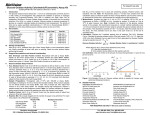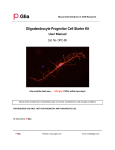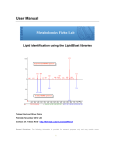Download data sheet - BioVision
Transcript
BioVision rev. 01/14 I. Introduction: Sialic acid is a generic term for the N- or O-substituted derivatives of neuraminic acid, a monosaccharide with a nine-carbon backbone. It is also the name for the most common member of this group, N-acetylneuraminic acid. Sialic acids are found widely distributed in animal tissues and to a lesser extent in other species ranging from plants and fungi to yeasts and bacteria, mostly in glycoproteins and gangliosides. It has been shown recently that sialic acid level may be associated with developmental and pathological stages. BioVision's Sialic Acid Assay Kit provides a simple and convenient means of measuring free Sialic Acid in a variety of biological samples. The kit utilizes an enzyme coupled reaction in which free sialic acid is oxidized resulting in development of the Oxi-Red probe to give fluorescence (Ex/Em=535/587 nm) and absorbance (OD=570 nm). The kit measures sialic acid in the linear range of 0.1 to 10 nmol with a detection sensitivity ~1 µM concentration. II. Kit Contents: Components K566-100 Cap Code Part No. Sialic Acid Assay Buffer Sialic Acid Probe (in DMSO) Sialic Acid Converting Enzyme Sialic Acid Development Mix Sialic Acid Standard (10 µmol) 25 ml 0.2 ml lyophilized lyophilized lyophilized WM Red Purple Green Yellow K566-100-1 K566-100-2A K566-100-4 K566-100-5 K566-100-6 III. Storage and Handling: Store the kit at -20oC, protect from light. Warm Assay Buffer to room temperature before use. Briefly centrifuge vials prior to opening. Read the entire protocol before the assay. IV. Reagent Reconstitution and General Consideration: Sialic Acid Probe: Ready to use as supplied. Warm to room temperature to melt frozen DMSO prior to use. Protect from light and moisture. Stable for 2 months at -20°C. Sialic Acid Converting Enzyme, Development Mix: Reconstitute with 220 µl Sialic acid Assay Buffer separately. Pipette up and down to dissolve. Keep the Enzyme and Development Mix on ice during use. Aliquot and store at –20oC if they will not all be used at once. Avoid repeated freeze/thaw cycles. Use within two months. Sialic Acid Standard: Dissolve in 100 µl dH2O to generate 100 mM (100 nmol/µl) Sialic acid Standard Solution. Keep on ice while in use. Store at -20°C. Ensure that the Assay Buffer is warmed to room temperature before the reaction. V. Sialic Acid Assay Protocol: 1. Standard Curve: For the Colorimetric Assay: Dilute 10 µl of the 100 mM Sialic Acid Standard with 990 µl dH2O to generate 1 mM standard Sialic Acid. Add 0, 2, 4, 6, 8, 10 µl of the diluted Sialic Acid Standard into a 96-well plate to generate 0, 2, 4, 6, 8, 10 nmol/well standard. Bring the volume to 50 µl with Assay Buffer. For the Fluorometric Assay: Dilute the standard to 0.1 mM (0.1 nmol/µl), then follow the same protocol as colorimetric assay. Will give 0, 0.2, 0.4, 0.6, 0.8, 1 nmol/well Standard. 2. Sample Preparation: Samples can be tested for free sialic acid or hydrolyzed to measure bound sialic acid as well. There are a variety of hydrolysis protocols, and users should be cautious in selecting which protocol to use. Once the sample has been prepared, add samples to a 96-well plate and bring the volume to 50 μl/well with Assay Buffer. We suggest testing several doses of your sample to make sure the readings are within the standard curve range. 3. Reaction Mix: Mix enough reagents for the number of assays to be performed. For each well, prepare a total 50 μl Reaction Mix containing: Sialic Acid Measurement Background Control* Assay Buffer 44 μl 46 µl Sialic Acid Converting Enzyme 2 μl ------Sialic Acid Development Mix 2 μl 2 μl Sialic Acid Probe** 2 μl 2 μl *Pyruvate will generate background. If a significant amount of pyruvate is suspected in your sample, you may do a background control. Do pyruvate background control without Sialic Acid Converting Enzyme, which will detect only endogenous pyruvate, but not Sialic Acid. The pyruvate background should be subtracted from Sialic Acid. ** For the fluorescent assay, dilute the probe 10X to reduce background reading. Add 50 μl of the Reaction Mix to each well containing the Sialic acid standard and test samples. Mix well. Incubate the reaction for 30 min at room temperature, protect from light. 4. Measure OD at 570 nm or fluorescence at Ex/Em 535/587 nm in a microplate reader. 5. Calculation: Correct background by subtracting the value derived from the 0 Sialic Acid control from all sample and standard readings (The background reading can be significant and must be subtracted from sample readings). Plot Sialic Acid standard curve. Apply sample readings to the standard curve. Sialic Acid concentrations of the test samples can then be calculated: C = Sa/Sv (nmol/μl, or mM) Where Sa is the Sialic acid content of unknown samples (in nmol) from standard curve Sv is sample volume (in μl) added into the assay wells. Sialic acid Molecular Weight is 309.3 g/mol. 10000 y = 0.1393x - 0.003 1.2 y = 8912.7x + 78.371 8000 RFU (Catalog #K566-100; 100 Reactions; Store kit at –20oC) OD 570 nm Sialic Acid (NANA) Colorimetric/Fluorometric Assay Kit For research use only 0.8 0.4 6000 4000 2000 0 0 0 2 4 6 8 10 nmol Sialic Acid RELATED PRODUCTS: NAD(P)/NAD(P)H Quantification Kit Ascorbic Acid Quantification Kit Total Antioxidant Capacity (TAC) Assay Kit Ethanol Assay Kit Pyruvate Assay Kit Creatinine Assay Kit Ammonia Assay Kit Triglyceride Assay Kit Choline/Acetylcholine Quantification Kit Sarcosine Assay Kit Glycogen Assay Kit Phosphatase Assay Kits 0 0.2 0.4 0.6 0.8 1 nmol Sialic Acid ADP/ATP Ratio Assay Kit Glutathione Detection Kit Fatty Acid Assay Kit Uric Acid Assay Kit Lactate Assay Kit I & II Nitric Oxide Assay Kit Free Glycerol Assay Kit Hemin Assay Kit Glucose Assay Kit L-Amino Acid Assay Kit Cholesterol Assay Kit HDL/LDL Assay Kit FOR RESEARCH USE ONLY! Not to be used on humans. BioVision Incorporated 155 S. Milpitas Boulevard, Milpitas, CA 95035 USA Tel: 408-493-1800 | Fax: 408-493-1801 www.biovision.com | [email protected] Page 1 of 2 BioVision rev. 01/14 For research use only GENERAL TROUBLESHOOTING GUIDE: Problems Cause Solution Assay not working • Use of ice-cold assay buffer • Assay buffer must be at room temperature • Omission of a step in the protocol • Refer and follow the data sheet precisely • Plate read at incorrect wavelength • Check the wavelength in the data sheet and the filter settings of the instrument • Use of a different 96-well plate • Fluorescence: Black plates ; Luminescence: White plates ; Colorimeters: Clear plates • Use of an incompatible sample type • Refer data sheet for details about incompatible samples • Samples prepared in a different buffer • Use the assay buffer provided in the kit or refer data sheet for instructions • Samples were not deproteinized (if indicated in datasheet) • Use the 10 kDa spin cut-off filter or PCA precipitation as indicated • Cell/ tissue samples were not completely homogenized • Use Dounce homogenizer (increase the number of strokes); observe for lysis under microscope • Samples used after multiple free-thaw cycles • Aliquot and freeze samples if needed to use multiple times • Presence of interfering substance in the sample • Troubleshoot if needed, deproteinize samples • Use of old or inappropriately stored samples • Use fresh samples or store at correct temperatures till use • Improperly thawed components • Thaw all components completely and mix gently before use • Use of expired kit or improperly stored reagents • Always check the expiry date and store the components appropriately • Allowing the reagents to sit for extended times on ice • Always thaw and prepare fresh reaction mix before use • Incorrect incubation times or temperatures • Refer datasheet & verify correct incubation times and temperatures • Incorrect volumes used • Use calibrated pipettes and aliquot correctly • Use of partially thawed components • Thaw and resuspend all components before preparing the reaction mix • Pipetting errors in the standard • Avoid pipetting small volumes • Pipetting errors in the reaction mix • Prepare a master reaction mix whenever possible • Air bubbles formed in well • Pipette gently against the wall of the tubes • Standard stock is at an incorrect concentration • Always refer the dilutions in the data sheet • Calculation errors • Recheck calculations after referring the data sheet • Substituting reagents from older kits/ lots • Use fresh components from the same kit • Measured at incorrect wavelength • Check the equipment and the filter setting • Samples contain interfering substances • Troubleshoot if it interferes with the kit • Use of incompatible sample type • Refer data sheet to check if sample is compatible with the kit or optimization is needed • Sample readings above/below the linear range • Concentrate/ Dilute sample so as to be in the linear range Samples with erratic readings Lower/ Higher readings in Samples and Standards Readings do not follow a linear pattern for Standard curve Unanticipated results Note: The most probable list of causes is under each problem section. Causes/ Solutions may overlap with other problems. BioVision Incorporated 155 S. Milpitas Boulevard, Milpitas, CA 95035 USA Tel: 408-493-1800 | Fax: 408-493-1801 www.biovision.com | [email protected] Page 2 of 2






